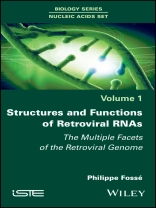One family of viruses is responsible for the infection of many species of vertebrates. These are the retroviruses whose genomic RNA is used to support genetic information and ensures many essential functions that are required for the formation of an infectious viral particle. These functions depend on structures formed by the folding of the genomic RNA.
Structures and Functions of Retroviral RNAs describes the formation of these structures and their specific interactions with nucleic acids and proteins. In light of recent advances in molecular virology, it provides an understanding of the various facets of the retroviral genome. It emphasizes in particular that the study of the structure-function relationship of retroviral RNAs is a driving force behind increased research into HIV-1, the main causal agent of AIDS.
Indeed, one of the challenges of pharmacology lies in the exploitation of several targets which allow us to anticipate and stem the emergence of resistance to anti-HIV drugs. The book also presents structures and interactions that may be potential future targets in this regard.
Tabela de Conteúdo
Foreword vii
Marylène MOUGEL
Preface xi
Chapter 1 General Information on Retroviruses 1
1.1 Common characteristics of retroviruses 1
1.1.1 Untranslated regions 2
1.1.2 Translated regions 3
1.2 Architecture of the virion 5
1.3 Replication cycle of retroviruses 6
1.3.1 Early phase 7
1.3.2 Late phase 9
Chapter 2 Effects of the Structure of Retroviral RNA on Reverse Transcription 11
2.1 Reverse transcription of genomic RNA 11
2.2 RNA structures involved in the initiation of reverse transcription 14
2.2.1 A cellular t RNA as RT primer 14
2.2.2 Formation of the template-primer duplex 16
2.2.3 Role of the structure of the template-primer duplex upon initiation 19
2.3 RNA structures involved in the first strand transfer 21
2.3.1 Actors involved in the first strand transfer 21
2.3.2 Molecular basis of R-r pairing 22
2.4 RNA structures promoting genetic recombination 26
2.4.1 Internal strand transfer 26
2.4.2 RNA structures triggering internal strand transfer 28
Chapter 3 RNA Structures Regulating the Expression of the Retroviral Genome 31
3.1 Regulatory RNA structures of proviral DNA transcription 31
3.1.1 The transcriptional activator Tat 31
3.1.2 TAR structures with one stem-loop 33
3.1.3 TAR structures with two stem-loops 37
3.2 RNA structures regulating genomic RNA maturation 38
3.2.1 The negative regulator of splicing of RSV 39
3.2.2 Structural diversity and alternative splicing in HIV-1 41
3.3 RNA structures regulating the export of retroviral RNAs 44
3.3.1 Export of unspliced RNA in simple retroviruses 44
3.3.2 Unspliced RNA export in complex retroviruses 53
3.4 RNA structures regulating the translation of retroviral RNAs 60
3.4.1 IRESs of simple retroviruses 61
3.4.2 Translation initiation in complex retroviruses 63
Chapter 4 Encapsidation of Genomic RNA in the Retroviral Particle 73
4.1 RNA structures and mechanisms governing g RNA dimerization 73
4.1.1 Structures and mechanisms in alpharetroviruses 74
4.1.2 Structures and mechanisms in betaretroviruses 77
4.1.3 Structures and mechanisms in deltaretroviruses 79
4.1.4 Structures and mechanisms in gammaretroviruses 81
4.1.5 Structures and mechanisms in lentiviruses 85
4.2 RNA structures and mechanisms regulating g RNA encapsidation 96
4.2.1 Structures and mechanisms in alpharetroviruses 96
4.2.2 Structures and mechanisms in betaretroviruses 99
4.2.3 Structures and mechanisms in deltaretroviruses 104
4.2.4 Structures and mechanisms in gammaretroviruses 106
4.2.5 Structures and mechanisms in lentiviruses 108
Conclusion 115
Glossary 117
List of Acronyms 121
References 127
Index 159
Sobre o autor
Philippe Fossé is a research director at the CNRS and also works at the Ecole normale supérieure Paris-Saclay, France. His research focuses primarily on the structure-function relationship of the nucleic acids that regulate the reverse transcription of the HIV-1 genome.












